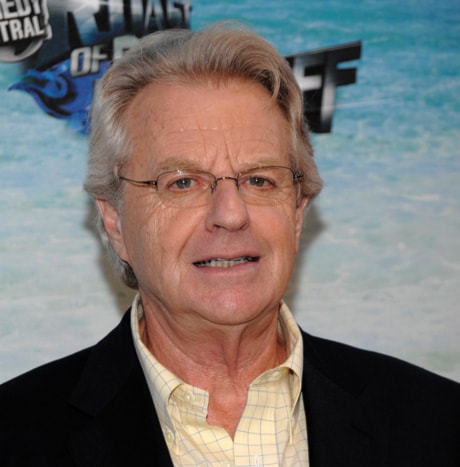NEW YORK — Thanks to Jerry Springer, the idea of a midget standing on a table to start a food fight or passionately kissing her sister on a daytime TV show doesn’t seem so shocking anymore.
Springer’s theatre of the absurd is like video wallpaper now, as he celebrates his 20th season on the air Wednesday with an episode filmed in New York’s Times Square that plays back some of the memorable wig-pulling, chin-smacking and turkey-tossing moments of the past.
“It’s become an institution,” Bill Carroll, an analyst of television’s syndication market for Katz Television, said.
Springer’s show doesn’t get high ratings, not like in the early 1990s when he briefly challenged The Oprah Winfrey Show for supremacy. But it is a dependable performer, Katz said, and owner NBC Universal said this week it had already sold the show to stations in key markets such as New York and Los Angeles through mid-2014.
“I don’t watch the show, but it’s not aimed at 66-year-old men,” Springer said. “If I were in college, I would watch. I enjoy doing it. It’s a lot of fun.”
Springer infrequently stands on his show’s stage, usually prowling with a microphone among audience members and acting like a ringmaster for themed programs such as Wives Battle Mistresses, Midget Holiday Hell and Guess What? I’m a Man! Transsexuals revealing their “secret” to dating partners, love triangles and romantic betrayals are frequent topics, designed to deliver an onstage moment of shock.
Former U.S. Education Secretary William Bennett called talk show hosts like Springer “perpetrators of cultural rot,” in a 1995 news conference aimed at cleaning up daytime TV where he was joined by U.S. Sen. Joseph Lieberman, R-Conn.
Now Springer films his episodes in a production facility in Lieberman’s hometown of Stamford, Conn.
Politicians have largely moved on from Springer. (Representatives for Bennett and Lieberman did not immediately return calls for comment.)
“They don’t have to say to their guests, ‘Be outrageous,”’ Katz said. “They all come to the show, they’ve all grown up with the show. They know what their role is. The more outrageous, the more memorable. For some folks, it’s reality television and for some folks, it’s comedic. It has developed its own genre.”
Many of the stations that air Springer pair his show with others hosted by Steve Wilkos, a former Springer security guard, and the colourful Maury Povich, he said.
Springer, a former mayor of Cincinnati, was a local news anchor in the same city when his station’s parent company assigned him to host a new talk show. The first episode aired in September 1991.
At first, it was conventional, chasing after the same audience of middle-aged women that Oprah Winfrey owned. Springer said he made his only substantive decision on the show’s future: go young.
“Well, young people are much more open about their lives. They’re much wilder, and that’s when the show started to go crazy,” he said.
For the first fight — an audience member rushing the stage to confront a Ku Klux Klan member — Springer didn’t even have security guards. He worried the show would be in trouble. It wasn’t.
When the show’s rights were first bought out, “they said from now on we’re only allowed to do crazy,” Springer said.
“The culture of television changed,” he said.
“The world didn’t change. There’s nothing that’s ever been on any of our shows that a grownup didn’t know existed. There’s nothing shocking in the show. What was shocking was that we had never seen it on television before.”
